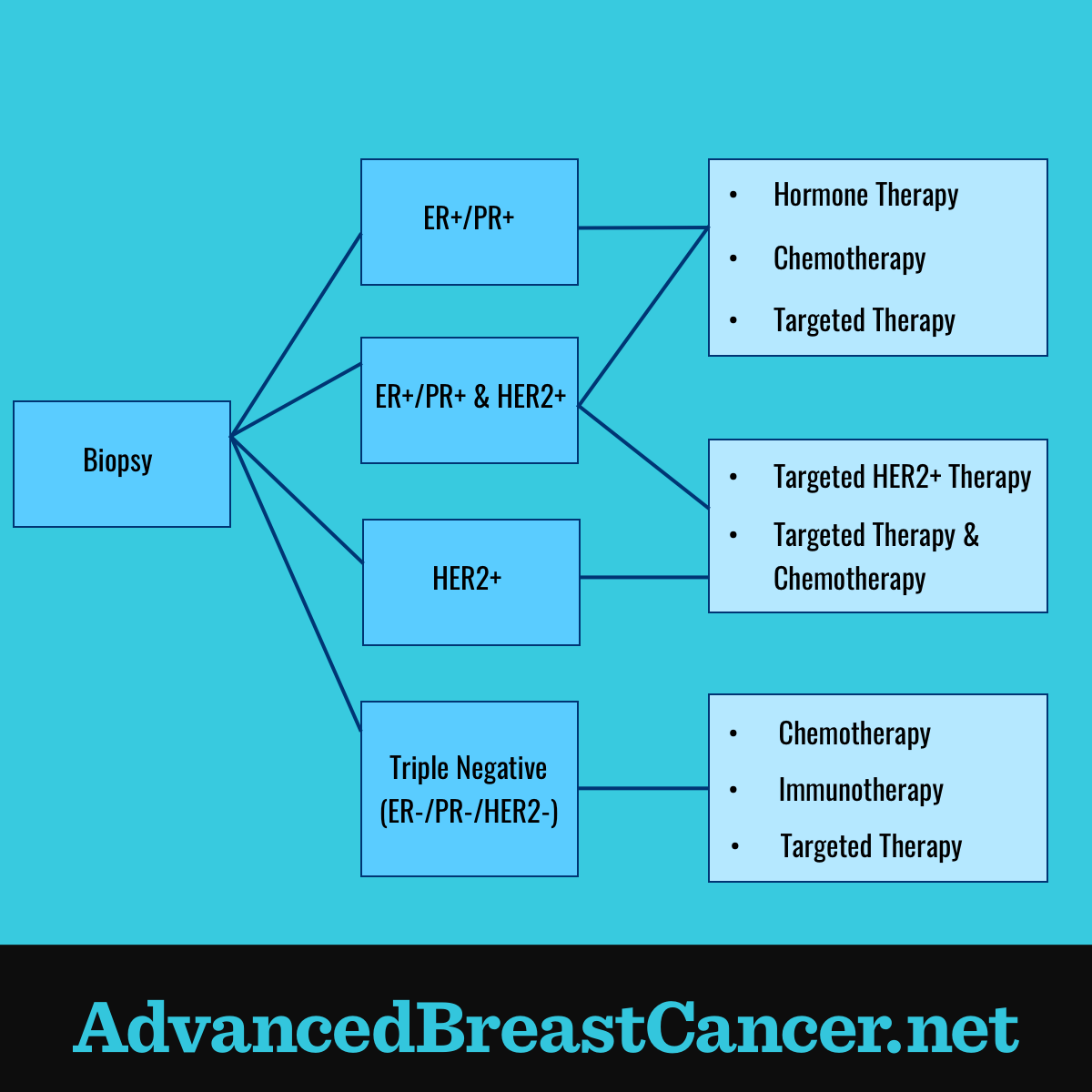Treating Different Types of Breast Cancer
Reviewed by: HU Medical Review Board | Last reviewed: July 2025 | Last updated: July 2025
The term "breast cancer" refers to any cancer that begins in the breast cells. However, there is much variation between different kinds of breast cancer. These different subtypes play an important role in determining treatment paths.1,2
Advanced breast cancer (ABC) treatment can be complex. You may require several forms of treatment over time to manage the cancer. You may also need care from multiple specialists.1,2
Testing breast cancer for receptor status
A biopsy is used to confirm a diagnosis of breast cancer. This is when a sample of tissue is removed from the body to be studied under a microscope.3
Biopsies are also important for people who have experienced a recurrence of breast cancer. These cancers that come back after previous treatment may have changed or evolved over time. Biopsy samples are examined for the following receptors on the surface of the cancer cells:3
- Human epidermal growth factor receptor 2 (HER2)
- Hormone receptors (HR), including estrogen receptors (ER) and progesterone receptors (PR)
Information about the status of these receptors helps guide doctors in recommending treatment.3
Subtypes of breast cancer
There are several subtypes of breast cancer, which are based on a person's hormone receptor status. These include:3,4
- Hormone receptor-positive – Breast cancer cells test positive for either ER or PR receptors, or both. These breast cancers tend to grow more slowly than hormone receptor-negative breast cancers.
- Hormone receptor-negative – Breast cancer cells test negative for ER and PR receptors. These breast cancers tend to grow faster than hormone receptor-positive breast cancers.
- Triple-positive – Breast cancer cells are ER-positive, PR-positive, and HER2-positive. Hormone therapy and drugs that specifically target HER2 (targeted therapy) are typically used to treat these breast cancers.
- Triple-negative – Breast cancer cells test negative for all the above receptors. These breast cancers tend to be aggressive, meaning they can grow and spread quickly. While there have historically been limited targeted treatments for people with triple-negative breast cancers, newer treatment options are emerging.
A newly explored subtype of breast cancer is known as HER2-low. In this type, cancer cells have some HER2 on their surface, but in a smaller amount than HER2-positive breast cancer. This makes it harder for drugs that target HER2 to work well. Some drug treatments for this subtype are available, and others are being studied.4,5
Figure. Treatment options by subtype
Hormone therapy
Hormone therapy, also called endocrine therapy, is used in people who have hormone receptor-positive (ER-positive or PR-positive) breast cancer. Blocking the hormones can help stop or slow these cancers from growing and spreading.3
Targeted therapy
Targeted therapy works to stop or slow the growth and spread of cancer. This is done by blocking parts of cancer cells that are involved in their growth, or by focusing on specific features that are unique to cancer cells. Several targeted therapies are used to treat certain breast cancers. Their targets include:6
- HER2-positive
- CDK 4/6 (cyclin-dependent kinase 4/6)
- PARP (poly [ADP-ribose] polymerase)
- mTOR (mammalian target of rapamycin)
- PI3K
- AKT
- Certain cell features targeted by antibody-drug conjugates
Immunotherapy
Immunotherapy is a type of treatment that aims to boost the immune system to fight cancer. Several types of immunotherapy are being studied or have been approved for the treatment of certain forms of breast cancer. They include:7
- Monoclonal antibodies
- Adoptive cell transfer
Chemotherapy
Chemotherapy is the use of drugs to kill cancer cells. Chemotherapy drugs work by targeting rapidly dividing cells, like cancer cells.8
The choice to use chemotherapy drugs in someone with metastatic breast cancer depends on several factors, including previous chemotherapy treatment. Rather than a combination of drugs, a single chemotherapy drug is typically used to treat metastatic breast cancer. This is called monotherapy. But the choice of chemotherapy drug(s) is based on each person's breast cancer and condition.8
Surgery
Regardless of the subtype, surgery may be used to treat ABC. Surgery may not be an option for certain cases of ABC. Or surgery may be an option only after other treatment, like chemotherapy, has shrunk the tumor. Surgery options include breast-conserving tumor removal (lumpectomy) and surgical removal of the breast (mastectomy).9
Symptom management
All people with ABC can benefit from symptom management. This is also known as supportive or palliative care. Palliative care can improve quality of life by addressing:10
- Side effects of treatment
- Symptoms of the disease
- Emotional and spiritual support
Advanced or metastatic clinical trials
People with advanced or metastatic breast cancer can also consider joining a clinical trial. There are different types of clinical trials. Some offer new treatments that are not currently available to the general public. Talk to your doctor about the possibility of participating in a clinical trial and whether clinical trials are a good option for you.11
